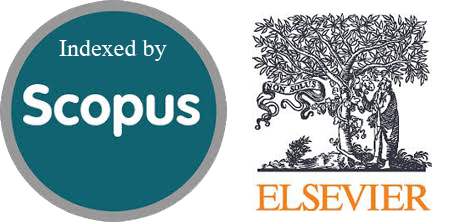Utilization of Household Organic Waste into Biogas and Integrated with IoT
Abstract
The increase in population impacts several environmental sectors, particularly the use of natural gas energy for household needs, such as LPG (Liquefied Petroleum Gas). This has resulted in the depletion of natural gas reserves and a rise in LPG imports. Additionally, the growing population contributes to the accumulation of household waste, which can lead to excessive leachate production and greenhouse gas emissions. This issue is particularly concerning in developing countries like Indonesia due to its negative environmental impact. This research aims to provide a solution and contribute to reducing household waste accumulation by utilizing organic waste to create renewable energy in the form of biogas as an alternative to LPG. Biogas is produced through the fermentation of organic waste. Nutrient-rich fluids containing sugar can enhance the performance of methanogenic bacteria in biogas formation. In this study, we conducted nutritional testing on molasses and coconut water to determine which nutrients optimize biogas production efficiency by monitoring the pressure of the generated biogas. Generally, biogas comprises methane and carbon dioxide. It is important to note that excessive methane can lead to explosions, while high carbon dioxide levels contribute to greenhouse gas emissions. The quantities of methane and carbon dioxide produced during biogas generation can be influenced by temperature and humidity. Therefore, monitoring pressure, temperature, humidity, methane, and carbon dioxide levels in the biogas production process using the Internet of Things (IoT) is a prudent approach. The results indicate that a substrate mixed with molasses produces biogas at twice the pressure compared to coconut water. Furthermore, optimal biogas production with ideal methane and carbon dioxide levels, occurs at temperatures between 25-35°C under high humidity conditions. This suggests that mesophilic methanogenic bacteria thrive in tropical climates.
Downloads
References
Ernawati, S. Nurjanah, N. P. Adriana, E. N. Pratiwi, and A. Apriani, “The Effect of Counseling on Family Planning Acceptors in Decision Making on Contraceptive Devices during the Postpartum Period,” Formosa J. Sci. Technol., vol. 1, no. 5, pp. 593–602, 2022, doi: 10.55927/fjst.v1i5.1277.
I. F. U. Muzayanah, H. H. Lean, D. Hartono, K. D. Indraswari, and R. Partama, “Population density and energy consumption: A study in Indonesian provinces,” Heliyon, vol. 8, no. 9, p. e10634, 2022, doi: 10.1016/j.heliyon.2022.e10634.
M. B. Latif, M. A. Islam, M. S. Hossain, and S. S. Aurpa, “Effect of Sludge Content on the Decomposition of Different Types of Food Waste,” Sustain., vol. 15, no. 3, 2023, doi: 10.3390/su15032782.
M. M. Adrian, E. P. Purnomo, A. Enrici, and T. Khairunnisa, “Energy transition towards renewable energy in Indonesia,” Herit. Sustain. Dev., vol. 5, no. 1, pp. 107–118, 2023, doi: 10.37868/hsd.v5i1.108.
F. Ríos, F. Caparrós-Salvador, M. Lechuga, and M. Fernández-Serrano, “Complete biodegradability assessment of polyoxyethylene glycerol ester non-ionic surfactant: Aerobic, anaerobic, combined biodegradation and inhibitory effects,” Water Res., vol. 248, no. October 2023, 2024, doi: 10.1016/j.watres.2023.120857.
J. Joshi et al., “Integrating microbial electrochemical cell in anaerobic digestion of vegetable wastes to enhance biogas production,” Bioresour. Technol. Reports, vol. 27, no. August, p. 101940, 2024, doi: 10.1016/j.biteb.2024.101940.
K. H. Phan et al., “Anaerobic biodegradation of mixed azo dyes in thermophilic and mesophilic conditions,” Case Stud. Chem. Environ. Eng., vol. 9, no. February, p. 100667, 2024, doi: 10.1016/j.cscee.2024.100667.
L. R. Machado, A. H. Ferrarez, J. L. Junior, and F. C. Alves, “Biogas production and composition optimization in an anaerobic digestor using cheese whey and swine manure as substrate,” Acta Sci. - Technol., vol. 44, 2022, doi: 10.4025/actascitechnol.v44i1.56923.
N. D. Susetyo, F. Rhohman, and M. M. Ilham, “Perbandingan Zat Penyusun Dalam Pemanfaatan Limbah Cair Tahu Sebagai Energi Alternatif Biogas,” J. Mesin Nusant., vol. 2, no. 2, pp. 109–118, 2020, doi: 10.29407/jmn.v2i2.14185.
S. Theuerl et al., The future agricultural biogas plant in Germany: A vision, vol. 12, no. 3. 2019. doi: 10.3390/en12030396.
I. K. A. Atmika, K. Sebayuana, T. G. T. Nindhia, I. W. Surata, I. Putu Ari Astawa, and A. A. I. A. S. Komaladewi, “The effect of loading rate to biogas production rate of the 500 liter anaerobic digester operated with continuous system,” E3S Web Conf., vol. 120, no. 201 9, pp. 10–13, 2019, doi: 10.1051/e3sconf/201912002004.
S. Thiruketheeswaranathan and A. Dharshayini, “Design of Small-scale Biogas Plant for Household Need,” Middle East J. Appl. Sci. Technol., vol. 04, no. 03, pp. 40–43, 2021, doi: 10.46431/mejast.2021.4305.
K. Maurus, N. Kremmeter, S. Ahmed, and M. Kazda, “High-resolution monitoring of VFA dynamics reveals process failure and exponential decrease of biogas production,” Biomass Convers. Biorefinery, vol. 13, no. 12, pp. 10653–10663, 2023, doi: 10.1007/s13399-021-02043-2.
A. Mukasine, L. Sibomana, K. Jayavel, K. Nkurikiyeyezu, and E. Hitimana, “Correlation Analysis Model of Environment Parameters Using IoT Framework in a Biogas Energy Generation Context,” Futur. Internet, vol. 15, no. 8, 2023, doi: 10.3390/fi15080265.
S. P. Wijaya, S. Ainun, and D. A. Permadi, “Methane Emission Estimation and Dispersion Modeling for a Landfill in West Java, Indonesia,” J. Civ. Eng. Forum, vol. 7, no. 3, p. 239, 2021, doi: 10.22146/jcef.62824.
S. He, L. Su, H. Fan, and R. Ren, “Methane explosion accidents of tunnels in SW China,” Geomatics, Nat. Hazards Risk, vol. 10, no. 1, pp. 667–677, 2019, doi: 10.1080/19475705.2018.1541826.
E. Gul, G. Baldinelli, A. Farooqui, P. Bartocci, and T. Shamim, “AEM-electrolyzer based hydrogen integrated renewable energy system optimisation model for distributed communities,” Energy Convers. Manag., vol. 285, no. April, p. 117025, 2023, doi: 10.1016/j.enconman.2023.117025.
S. Wang, F. Ma, W. Ma, P. Wang, G. Zhao, and X. Lu, “Influence of temperature on biogas production efficiency and microbial community in a two-phase anaerobic digestion system,” Water (Switzerland), vol. 11, no. 1, 2019, doi: 10.3390/w11010133.
S. Villamil, C. Hernández, and G. Tarazona, “An overview of internet of things,” Telkomnika (Telecommunication Comput. Electron. Control., vol. 18, no. 5, pp. 2320–2327, 2020, doi: 10.12928/TELKOMNIKA.v18i5.15911.
M. Mina and K. Kartika, “Monitoring System for Levels of Voltage, Current, Temperature, Methane, and Hydrogen in IoT-Based Distribution Transformers,” Int. J. Eng. Sci. Inf. Technol., vol. 3, no. 1, pp. 22–27, 2023, doi: 10.52088/ijesty.v3i1.414.
F. N. Abbas, I. M. Saadoon, Z. K. Abdalrdha, and E. N. Abud, “Capable of gas sensor MQ-135 to monitor the air quality with arduino uno,” Int. J. Eng. Res. Technol., vol. 13, no. 10, pp. 2955–2959, 2020, doi: 10.37624/IJERT/13.10.2020.2955-2959.
M. A. Hailan, B. M. Albaker, and M. S. Alwan, “Transformation to a smart factory using NodeMCU with Blynk platform,” Indones. J. Electr. Eng. Comput. Sci., vol. 30, no. 1, pp. 237–245, 2023, doi: 10.11591/ijeecs.v30.i1.pp237-245.
W. Romaniuk et al., “Study of Technological Process of Fermentation of Molasses Vinasse in Biogas Plants,” Processes, vol. 10, no. 10, 2022, doi: 10.3390/pr10102011.
G. M. Salkhozhayeva, K. M. Abdiyeva, S. Y. Arystanova, and G. D. Ultanbekova, “Technological Process of Anaerobic Digestion of Cattle Manure in a Bioenergy Plant,” J. Ecol. Eng., vol. 23, no. 7, pp. 131–142, 2022, doi: 10.12911/22998993/149516.
Copyright (c) 2024 Jurnal RESTI (Rekayasa Sistem dan Teknologi Informasi)

This work is licensed under a Creative Commons Attribution 4.0 International License.
Copyright in each article belongs to the author
- The author acknowledges that the RESTI Journal (System Engineering and Information Technology) is the first publisher to publish with a license Creative Commons Attribution 4.0 International License.
- Authors can enter writing separately, arrange the non-exclusive distribution of manuscripts that have been published in this journal into other versions (eg sent to the author's institutional repository, publication in a book, etc.), by acknowledging that the manuscript has been published for the first time in the RESTI (Rekayasa Sistem dan Teknologi Informasi) journal ;








